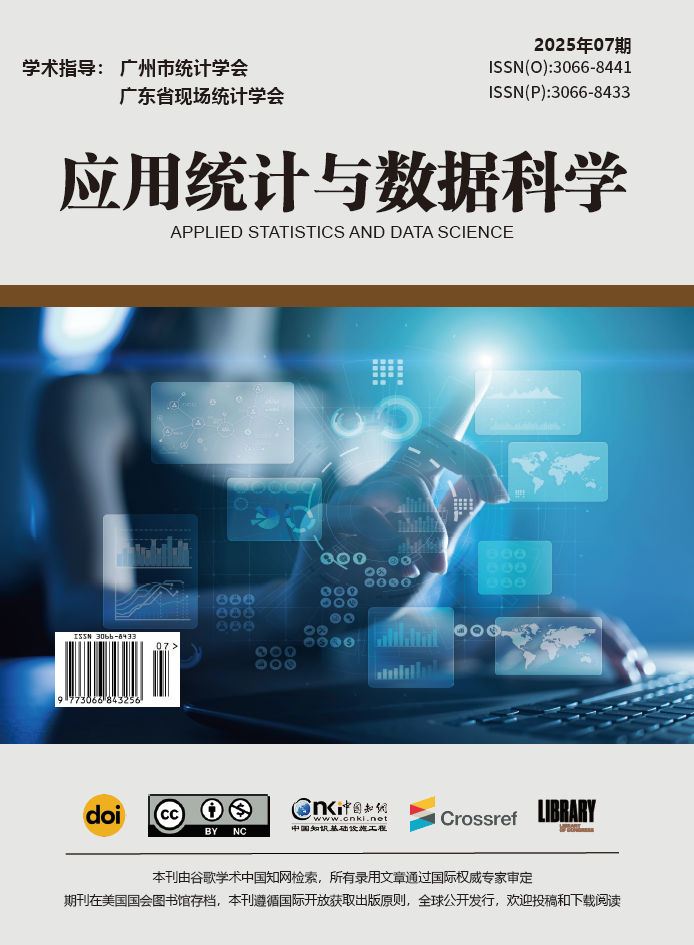Volume 1,Issue 7
Fall 2025
融合深度学习与动态因子分析的省际经济差异测度分析
本研究构建“DAE-GNN-LSTM-DFA”融合框架,深入分析中国31个省份2018-2022年的经济数据。鉴于传统静态分析工具难以捕捉“空间- 时序”耦合特征,此框架以DAE 提取经济数据特征,用GNN 建模省际空间依赖,结合LSTM-DFA 捕捉经济周期动态关系。结果显示,DAE 降维保信息且重构误差远低于PCA;GNN 聚类效果提升,轮廓系数达0.6625;LSTM-DFA 增强了传统动态因子分析的时变解释力。该混合模型在预测精度和拟合优度上优于其他对比模型,为区域协调发展及发展中国家经济差异治理提供参考。
[1]Chen, L., & Fan, J. (2023). High-dimensional factor analysis with unknown factors. Journal of Econometrics, 235(2), 1235-1257.
[2]Liu, Y., & Wang, X. (2024). Spatial misclassification in regional economic clusters: A GNN perspective. Regional Studies, 58(3), 445-462.
[3]Zhang, K., et al. (2024). LSTM-enhanced dynamic factor models for provincial GDP forecasting. Journal of Applied Econometrics, 39(1), 89-108.
[4]Fujita M , Krugman P , Venables A J .The Spatial Economy: Cities, Regions, and International Trade[J].Mit Press Books, 2001, 1(1):283-285.
[5]Bai, J., & Ng, S. (2002). Determining the number of factors in approximate factor models. Econometrica, 70(1), 191-221.
[6]Chen, E. Y., & Fan, J. (2021). Statistical Inference for High-Dimensional Matrix-Variate Factor Models. Journal of the American Statistical Association, 118(542), 1038–1055.
[7]Kingma, D. P., & Welling, M. (2013). Auto-encoding variational bayes. arXiv preprint arXiv:1312.6114.
[8]Li, Y., Wang, H., & Zhang, Z. (2023). Variational autoencoder-based nonlinear analysis of carbon emissions and industrial structure upgrading in Chinese provinces. Energy Economics, 126, 106902.
[9]Kipf, T. N. (2016). Semi-supervised classification with graph convolutional networks. arXiv preprint arXiv:1609.02907.
[10]Yoon, J. (2021). Forecasting of real GDP growth using machine learning models: Gradient boosting and random forest approach. Computational Economics, 57(1), 247–265.
[11]Jena, P. R., Majhi, R., Kalli, R., Managi, S., & Majhi, B. (2021). Impact of covid-19 on GDP of major economies: Application of the artificial neural network forecaster. Economic Analysis and Policy, 69, 324–339.
[12]Zhang, Q., Ni, H., & Xu, H. (2023). Nowcasting Chinese GDP in a data-rich environment: Lessons from machine learning algorithms. Economic Modelling, 122, 106204.
[13] 高金敏, & 郭佩佩等. (2021). 基于自回归XGBoost 时序模型的GDP 预测实证. 数学的实践与认识, (07),9-16.
[14] 朱青, & 周石鹏. (2021). 基于 LSTM 模型的国民经济 GDP 增长预测建模研究. 经济研究导刊, (19), 5-9.
[15]Bengio, Y., LeCun, Y., & Hinton, G. (2023). Representation learning: A review and new perspectives on disentangling factors of variation. Nature Machine Intelligence,5(7), 730–740.
[16]Wu, J., Chen, L., & He, K. (2024). Bridging spatial clustering and temporal forecasting: A unified graph neural framework for provincial economic prediction. Annals of Regional Science, 82(1), 1–26.
[17]Liu, S., Zhang, Y., & Li, M. (2025). Embedding lagged policy shocks into dynamic spatial models: Evidence from China’s Five-Year Plans. China Economic Review, 85, 102245.
[18]Kingma, D. P., & Ba, J. (2014). Adam: A method for stochastic optimization. Proceedings of the 3rd International Conference on Learning Representations, 1-15.
[19]Wu, Z., Pan, S., Chen, F., Long, G., Zhang, C., & Yu, P. S. (2020). A comprehensive survey on graph neural networks. IEEE transactions on neural networks and learning systems, 32(1), 4-24.
[20]Mare, D. (2015). The oxford handbook of economic forecasting. Journal of the Operational Research Society, 66(12), 2102-2102.

